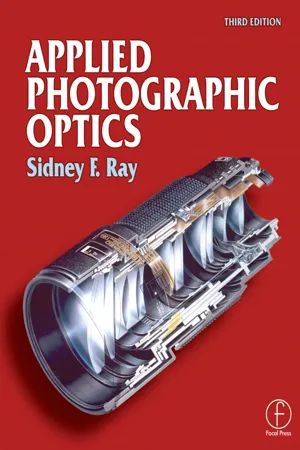
- 680 pages
- English
- ePUB (mobile friendly)
- Available on iOS & Android
Applied Photographic Optics
About this book
Selected by the American Library Association's 'Choice' magazine as "best technical book", the first edition of this book soon established itself as the standard reference work on all aspects of photographic lenses and associated optical systems. This is unsurprising, as Sidney Ray provides a complete, comprehensive reference source for anyone wanting information on photographic lenses, from the student to the practitioner or specialist working with visual and digital media worldwide.
This third edition has been fully revised and expanded to include the rapid progress in the last decade in optical technology and advances in relevant electronic and digital forms of imaging. Every chapter has been revised and expanded using new figures and photographs as appropriate, as well as extended bibliographies. New chapters include details of filters, measurements from images and the optical systems of digital cameras. Details of electronic and digital imaging have been integrated throughout. More information is given on topics such as aspherics, diffractive optics, ED glasses, image stabilization, optical technology, video projection and new types of lenses.
A selection of the contents includes chapters on: optical theory, aberrations, auto focus, lens testing, depth of field, development of photographic lenses, general properties of lenses, wide-angle lenses, telephoto lenses, video lenses, viewfinder systems, camera movements, projection systems and 3-D systems.
Frequently asked questions
- Essential is ideal for learners and professionals who enjoy exploring a wide range of subjects. Access the Essential Library with 800,000+ trusted titles and best-sellers across business, personal growth, and the humanities. Includes unlimited reading time and Standard Read Aloud voice.
- Complete: Perfect for advanced learners and researchers needing full, unrestricted access. Unlock 1.4M+ books across hundreds of subjects, including academic and specialized titles. The Complete Plan also includes advanced features like Premium Read Aloud and Research Assistant.
Please note we cannot support devices running on iOS 13 and Android 7 or earlier. Learn more about using the app.
Information
1 Introduction
2 The role of the lens in photography
2.1 Imaging
2.2 Recording
2.3 Measurement
2.4 Extension of visual perception
2.5 Self-expression
Further reading
3 Optical requirements
Table of contents
- Cover
- Half Title
- Title Page
- Copyright Page
- Table of Contents
- Acknowledgements
- Abbreviations and symbols used in text
- 1 Introduction
- 2 The role of the lens in photography
- 3 Optical requirements
- Optical theory
- Lens types and properties
- Photographic optical systems
- Index